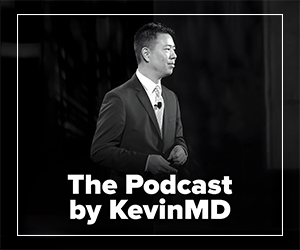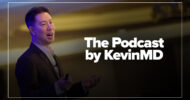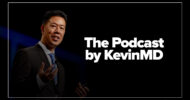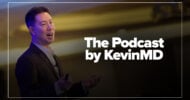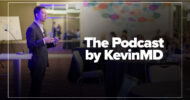Subscribe to The Podcast by KevinMD. Watch on YouTube. Catch up on old episodes!
Interventional physiatrist Francisco M. Torres discusses his article “The key to longevity: fitness, mindset, and nutrition.” He challenges societal assumptions about inevitable decline after age sixty, arguing that joy, vitality, and strength can thrive with the right approach. Francisco emphasizes a combination of factors: tailored fitness routines incorporating strength, cardiovascular, and flexibility exercises; listening to the body and finding personal joy in movement; and prioritizing nourishing foods like fruits, vegetables, whole grains, and lean proteins. Crucially, he highlights the power of mindset, citing research showing that “subjective age” and satisfaction with aging correlate more strongly with well-being and “flourishing” than chronological age does. Francisco stresses that viewing aging as enabling wisdom and experience, rather than limiting, combined with community connection through shared activities, is key to embracing health and vitality at any stage of life.
Our presenting sponsor is Microsoft Dragon Copilot.
Microsoft Dragon Copilot, your AI assistant for clinical workflow, is transforming how clinicians work. Now you can streamline and customize documentation, surface information right at the point of care, and automate tasks with just a click.
Part of Microsoft Cloud for Healthcare, Dragon Copilot offers an extensible AI workspace and a single, integrated platform to help unlock new levels of efficiency. Plus, it’s backed by a proven track record and decades of clinical expertise—and it’s built on a foundation of trust.
It’s time to ease your administrative burdens and stay focused on what matters most with Dragon Copilot, your AI assistant for clinical workflow.
VISIT SPONSOR → https://aka.ms/kevinmd
SUBSCRIBE TO THE PODCAST → https://www.kevinmd.com/podcast
RECOMMENDED BY KEVINMD → https://www.kevinmd.com/recommended
Transcript
Kevin Pho: Hi, and welcome to the show. Subscribe at KevinMD.com/podcast. Today we welcome back Francisco M. Torres. He’s an interventional physiatrist, and today’s KevinMD article is an excerpt from his new book. The excerpt is titled “The key to longevity: fitness, mindset, and nutrition.” The book is called Embracing Fitness as You Age: Maintaining a Healthy and Active Lifestyle Beyond 60. Francisco, welcome to the show.
Francisco M. Torres: Thank you so much for having me, Kevin.
Kevin Pho: All right. So tell us about this particular excerpt first, and then we will broaden up and talk about the book.
Francisco M. Torres: I just wanted to share my experience with my own process of aging. Later this year I’ll be turning 65, and I have had an incredible last 20 years of maintaining that fitness level.
I just wanted to write this down to share with a lot of people, like my patients and my family, and to be sure that people know that there’s an alternative to just accepting that as we age, we lose our abilities.
Kevin Pho: All right. So tell us about some of the tips that you’re using to stay healthy and fit as you approach 65.
Francisco M. Torres: I divided the book into several sections. The first one I started with was attitude. I believe that it is important just to have that youthful mentality and attitude. It’s not to pretend that you’re 20; it’s just to maintain that capacity to dream, to maintain that positive outlook. Also, I always say that you have to have a purpose, and that can change from day to day.
For me, in my example—and I always give my example—recently, for the last couple of years, I’ve been having grandkids after grandkids. So I have found a purpose because they look towards me. I did one of my physique bodybuilding shows one time. I brought my two-year-old, and he was just mesmerized by the process, and he looked at me. So when you have purpose, then it gives you the drive to look for how to train, why it’s so important to maintain this level of fitness.
The other thing that I talk about in the book is that our society assigns an aptitude based on your age. They’re constantly asking you, “Oh, how old are you? But you are supposed to behave this way.” And I’m trying to break those preconceived ideas. For example, when I go to the gym, people say, “Oh, he’s 60 and is lifting this much.” I say, “You know what? You should look at the others who are not lifting that much and say, that is the concern, not me. I should be the average.” So we’re trying to change that mentality, and it’s happening. That’s why I go into this in the book.
Well, especially with Hollywood now, Tom Cruise is doing his own stunts, and he’s my same age. So instead of going into a retirement community and quitting, they’re doing more and more outrageous things. And now it’s not unusual to have an 80-year-old breaking world records for their age.
So I think that one of the things that I always discuss in the book too is your mental strength. A couple of weeks ago, I ran a marathon in California. I hadn’t run a marathon in a while. I said, “Well, I’m going to do it. I just want to do it.” And to be honest with you, it was 90 percent the mind and 10 percent training. A lot of people were quitting, much younger than me. And then I saw an 87-year-old guy who finished the whole marathon. I don’t think that he was better trained. I think his mindset was, “I’m going to finish.” So he had a purpose for doing it.
Kevin Pho: So tell me about setting that mindset. How does one go about doing that? Is it something that they need to talk out with a coach or counselor? Is it something they sit down and just have that mindset? So what are some tips that you could share about setting that mindset?
Francisco M. Torres: The way I approach that is trying to educate yourself. For example, if I have a patient, that’s why I kind of put all my books on display, because then they are more comfortable talking about it, and they ask questions. Depending on how involved they are, if they have a strong “why” they want to do it, then we get into deeper and deeper ways of doing it. And everybody’s different; we work very differently.
For myself, my drive is that I have to compete. I have to do a show because if I don’t commit to it, then I don’t do it. So everybody has their own motivation. For example, me, when I go to the gym, I have to have a trainer. I will not do the same thing without the trainer that I do with the trainer, so if I want to excel, I have to have one. So I don’t see that as an expense; I see it as an investment in my health.
But there are other people who are very methodical. They’re dedicated, they can do it, they’re very competent. So we all have to identify our strengths and our weaknesses.
I do believe—and maybe because of my medical education, I like to keep learning—to this point, I’m still learning new protocols. For example, before I thought it was more about the heart rate or the blood pressure; now it’s the max. That is more reliable for longevity than anything else. But all those things are changing constantly. And for example, when you go to the gym, the type of exercise you do matters. If you want to build muscle, you do more repetitions. If you want to be stronger, then you cut down the repetitions and increase the weight. So you have to be selective about what you want to accomplish.
Kevin Pho: OK, so now we have that mindset that we’re talking about. What’s the next step?
Francisco M. Torres: I think that one important point that I want to bring up is that we have to take away the mentality that when we get older, we do cardio and that’s it. We have to change that mentality. We need to continue to lift weight. And when I talk to patients, they say, “Oh no, I’m too weak. I’m not going to be lifting,” or, “My kids are telling me, no, don’t do that. You’re going to get hurt.” Which is so wrong if you do it properly with the right technique. That is so crucial.
And for me, that’s so important because I saw my mother die from a fracture. My father died from a fracture. In my family, there are tons of deaths, not due to heart disease, but just from fractures. And that was because they didn’t believe at all in exercise. They didn’t see it that way. They thought, “Oh yeah, I’m active. I get in the car, I go to the restaurant, I come back to the house.” That was their life. So, and then some people say, “Well, that’s life.” But when you talk to them, they’re not happy. They’re not happy because all of a sudden…
Again, I just want to give you an example. I had a veteran who had a leg amputated. He was getting older, but I started telling him, “You need to start exercising because later on you’re going to need more energy because you’re missing a leg.” So he never listened to me. But now, recently I saw him back. He was two months in the hospital with pneumonia. Now he’s complaining that he’s so weak and he can’t get around, and he wants to be independent. And now he says, “Doctor, I should have listened to you.”
So what I’m trying to do is say, let’s not get to that stage. Let’s focus on prevention.
Kevin Pho: So for those who aren’t familiar with the gym and the various types of equipment, sometimes just lifting weights or strength training can be a little bit intimidating, right? Because sometimes cardio, which is just running or going on the treadmill, I think is a little bit more accessible now. Do you advise going to a trainer and learning about some of these basic strength training techniques? How does one get started if they aren’t familiar with the gym?
Francisco M. Torres: That’s an excellent question. So let me give you an example. When we had the pandemic, everything was shut down. I could not go to the gym. I depended on my trainer, so I was a little bit at a loss. I was not motivated to do it on my own. I didn’t have that drive. But then I kept doing research. What happened? They came out with a machine, Tonal. You put it on the wall. It’s like having a trainer; it controls your resistance. It guides you completely. You don’t need to go to the gym. So I replaced the gym with that.
Again, there’s some money behind that. But in my opinion, if you have the means and you have the desire, you definitely want to be educated. What I do with my patients that complain about the money is suggest, let’s start with physical therapy. Let’s just try to get a therapist that is in tune with exercise, and we can start that way. And then later on, if you want to join the gym with the trainer, fine.
For example, recently I went to a Planet Fitness for the first time, and oh my goodness, what a concept. They don’t have big bodybuilders; it’s very open to regular people, older people there. They’re coming in with wheelchairs, with walkers. And they have free classes within a membership, which is very minimal. So that would be an example of how to do it.
Kevin Pho: I do a lot of strength training myself. And you don’t even need a lot of equipment because there are a whole host of bodyweight exercises that one can do to help get started too, right?
Francisco M. Torres: Absolutely. When people are looking for an excuse, I mean, in my world of pain management, everybody comes up with the same excuse: “Oh, I have pain, I gained weight, I can’t lose it.” And I say, look, cardio is very inefficient for weight loss. We have to put that in their heads. You are not heavy because of a lack of exercise; it’s because of what you’re eating.
So once you educate them about inflammation—just because you’re overweight doesn’t mean that you’re going to have more pain, but the inflammation associated with it can cause more pain. So once you kind of explain the basics, they start understanding why they need to make better choices in what they’re eating.
So I think it all goes together. It’s the same thing if you go to the Blue Zones with all those centenarians. The common denominators are: plant-based diet, a lot of education, a lot of social interaction, attitudes where they want to continue to be active. Family, a lot of support. So all of that, if you look at all those zones, are basically the same common denominators.
Kevin Pho: Now for those people who are approaching 65 like yourself, how many times a week do you recommend strength training?
Francisco M. Torres: The lifting, the strength training, should be three times a week. You can do it for 45 minutes or half an hour, depending on the intensity you give to your training.
I always say that you can spend time… because I see people with a trainer, but they’re socializing. They use the trainer as a social hour, and you see them month after month in the gym, and they don’t change. They look the same. It’s because they go there and then they tell the doctor or their family, “Oh, I have a trainer. I go to the gym three times a week.” But if you go there to socialize, it’s not the same. It happens a lot.
Kevin Pho: All right, so we talked about the mindset, we talked about the exercise and strength training. How about nutritional tips? What kind of nutritional tips can you recommend?
Francisco M. Torres: All my recommendations are based on the Blue Zones because I’m into trying to reach that level. And 80 percent should be plant-based. And you might think that you’re not going to get enough protein, but studies comparing keto with plant-based diets show that plant-based by far surpasses the amount of protein.
I always tell my patients, I give them an idea of things that are addictive, like sugar, and also the hidden sugars, like in white rice, potatoes, and all those things that they don’t really think about. So I try to… my approach is Whole Foods, basically.
Kevin Pho: OK. Any supplements that you recommend?
Francisco M. Torres: I’m big, when my patients are looking into blocking inflammation, on turmeric and vitamin D3. But I go with a little bit higher dosage of the vitamin D3 with K2, and also berberine. I really do believe that it makes a difference.
Kevin Pho: OK. And what other recommendations do you have that your book focuses on?
Francisco M. Torres: One of the things, because I suffered from this myself, is injury recovery. The answer is not that old concept of RICE—rest, ice, compression, elevation—that’s changing. We have seen that the more you activate those structures, within limits and also with supervision, there is more potential for regeneration. So I think that mentality of “it hurts, I’m not going to use it” is changing. We’re seeing that evolving now.
For example, with lateral epicondylitis, my treatment is resistive exercise—extension and flexion—versus injection of cortisone and immobilizing with a brace. So I think that concept, now that we’re doing so many regenerative injections and therapies like that, is that we can stimulate healing with exercise as well. Yes, within limits, but we need to push ourselves.
I always tell my kids, when they say “good job” when you are striking out and they give you a trophy, that’s really not a good job. And that’s what we’re doing with, “Oh, I walked the dog.” “Oh, good job.” No, you didn’t increase your heart rate. You didn’t sweat. You didn’t do it for at least 15 or 20 minutes. I cannot tell you, “Good job.” You’re walking your dog every day. So, I think we have to be more demanding.
Again, the other concept I have to mention: we have this concept of overuse syndrome. I think we have more of a problem with the underuse syndrome. That’s basically what I believe.
Kevin Pho: Now for those people who are approaching age 65 or over age 60, and there are just so many options that are out there in terms of getting healthy. You go on social media, you read the news, and you have so many people giving you advice. Tell me your approach in terms of getting started.
Francisco M. Torres: I think nutrition is critical here because you need to control your weight so you can build up more muscle. We need to do this so we don’t have competition between the fat and the muscle. So that would be my first step. You need to detoxify yourself. You need to kind of go back to your pantry and start getting rid of things that are not going to be conducive to health.
Once you have that mindset that you’re trying to be healthier, then you have to establish habits or routines. We know for a fact that when we exercise in the morning—regardless if you are a night person or morning person—the benefits are higher. So I always say, if you’re a night person, I would recommend that you force yourself to become a day person.
Because we know also… what I included now, which keeps me focused, is meditation. I never thought I could. I’m a very type A personality. I couldn’t do meditation, but now I’ve been doing it for a year. Mandatory 30 minutes every day. Oh my goodness. And then when I go to the gym, those workouts are even more powerful because I’m focused.
The same thing applies to mindful eating. I try not to eat while I’m watching TV or driving, because we all do that; it’s just so convenient. And I guess I always say to everybody, my genetics are lazy because my parents just watched TV and ate. That was it. Or to celebrate, they’d go to the restaurant. There was no exercise, no hiking. Now my celebration, when I go somewhere—for example, I was going to Napa Valley—I want to go to Napa Valley, but I also want to run a marathon. I want to make it worth my while.
Kevin Pho: We’re here with Francisco Torres. He’s an interventional physiatrist, and we’re talking about his book, Embracing Fitness as You Age: Maintaining a Healthy and Active Lifestyle Beyond 60. Francisco, let’s end with some take-home messages that you want to leave with the KevinMD audience.
Francisco M. Torres: I think that you are never too old to change. You always have potential. There are people who started doing exercise and became high-end athletes when they were 60 or 70. That mentality can change. So I think: get educated, try to look for all this amount of information, but narrow it down to what works for you.
Kevin Pho: Francisco, thank you so much for sharing your perspective and insight. Thanks again for coming back on the show.
Francisco M. Torres: All right. Thank you.



